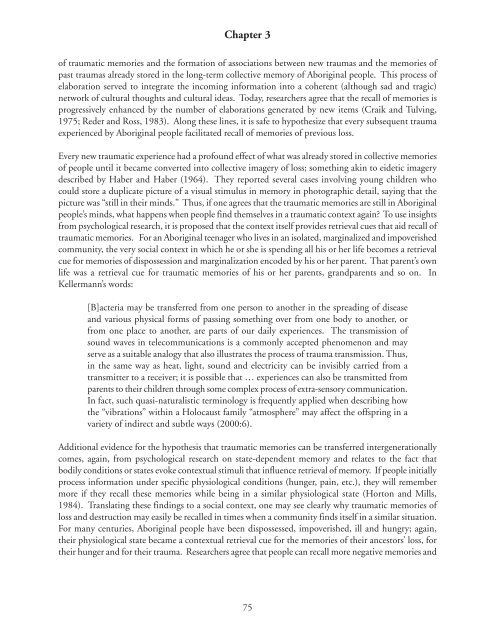Historic Trauma and Aboriginal Healing
by Cynthia C. Wesley-Esquimaux, Ph.D. and Magdalena Smolewski, Ph.D.
by Cynthia C. Wesley-Esquimaux, Ph.D. and Magdalena Smolewski, Ph.D.
You also want an ePaper? Increase the reach of your titles
YUMPU automatically turns print PDFs into web optimized ePapers that Google loves.
Chapter 3<br />
of traumatic memories <strong>and</strong> the formation of associations between new traumas <strong>and</strong> the memories of<br />
past traumas already stored in the long-term collective memory of <strong>Aboriginal</strong> people. This process of<br />
elaboration served to integrate the incoming information into a coherent (although sad <strong>and</strong> tragic)<br />
network of cultural thoughts <strong>and</strong> cultural ideas. Today, researchers agree that the recall of memories is<br />
progressively enhanced by the number of elaborations generated by new items (Craik <strong>and</strong> Tulving,<br />
1975; Reder <strong>and</strong> Ross, 1983). Along these lines, it is safe to hypothesize that every subsequent trauma<br />
experienced by <strong>Aboriginal</strong> people facilitated recall of memories of previous loss.<br />
Every new traumatic experience had a profound effect of what was already stored in collective memories<br />
of people until it became converted into collective imagery of loss; something akin to eidetic imagery<br />
described by Haber <strong>and</strong> Haber (1964). They reported several cases involving young children who<br />
could store a duplicate picture of a visual stimulus in memory in photographic detail, saying that the<br />
picture was “still in their minds.” Thus, if one agrees that the traumatic memories are still in <strong>Aboriginal</strong><br />
people’s minds, what happens when people find themselves in a traumatic context again? To use insights<br />
from psychological research, it is proposed that the context itself provides retrieval cues that aid recall of<br />
traumatic memories. For an <strong>Aboriginal</strong> teenager who lives in an isolated, marginalized <strong>and</strong> impoverished<br />
community, the very social context in which he or she is spending all his or her life becomes a retrieval<br />
cue for memories of dispossession <strong>and</strong> marginalization encoded by his or her parent. That parent’s own<br />
life was a retrieval cue for traumatic memories of his or her parents, gr<strong>and</strong>parents <strong>and</strong> so on. In<br />
Kellermann’s words:<br />
[B]acteria may be transferred from one person to another in the spreading of disease<br />
<strong>and</strong> various physical forms of passing something over from one body to another, or<br />
from one place to another, are parts of our daily experiences. The transmission of<br />
sound waves in telecommunications is a commonly accepted phenomenon <strong>and</strong> may<br />
serve as a suitable analogy that also illustrates the process of trauma transmission. Thus,<br />
in the same way as heat, light, sound <strong>and</strong> electricity can be invisibly carried from a<br />
transmitter to a receiver; it is possible that … experiences can also be transmitted from<br />
parents to their children through some complex process of extra-sensory communication.<br />
In fact, such quasi-naturalistic terminology is frequently applied when describing how<br />
the “vibrations” within a Holocaust family “atmosphere” may affect the offspring in a<br />
variety of indirect <strong>and</strong> subtle ways (2000:6).<br />
Additional evidence for the hypothesis that traumatic memories can be transferred intergenerationally<br />
comes, again, from psychological research on state-dependent memory <strong>and</strong> relates to the fact that<br />
bodily conditions or states evoke contextual stimuli that influence retrieval of memory. If people initially<br />
process information under specific physiological conditions (hunger, pain, etc.), they will remember<br />
more if they recall these memories while being in a similar physiological state (Horton <strong>and</strong> Mills,<br />
1984). Translating these findings to a social context, one may see clearly why traumatic memories of<br />
loss <strong>and</strong> destruction may easily be recalled in times when a community finds itself in a similar situation.<br />
For many centuries, <strong>Aboriginal</strong> people have been dispossessed, impoverished, ill <strong>and</strong> hungry; again,<br />
their physiological state became a contextual retrieval cue for the memories of their ancestors’ loss, for<br />
their hunger <strong>and</strong> for their trauma. Researchers agree that people can recall more negative memories <strong>and</strong><br />
75


















